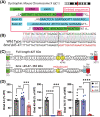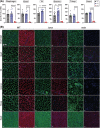The X-linked Becker muscular dystrophy (bmx) mouse models Becker muscular dystrophy via deletion of murine dystrophin exons 45-47
- PMID: 36628607
- PMCID: PMC10067474
- DOI: 10.1002/jcsm.13171
The X-linked Becker muscular dystrophy (bmx) mouse models Becker muscular dystrophy via deletion of murine dystrophin exons 45-47
Abstract
Background: Becker muscular dystrophy (BMD) is a genetic neuromuscular disease of growing importance caused by in-frame, partial loss-of-function mutations in the dystrophin (DMD) gene. BMD presents with reduced severity compared with Duchenne muscular dystrophy (DMD), the allelic disorder of complete dystrophin deficiency. Significant therapeutic advancements have been made in DMD, including four FDA-approved drugs. BMD, however, is understudied and underserved-there are no drugs and few clinical trials. Discordance in therapeutic efforts is due in part to lack of a BMD mouse model which would enable greater understanding of disease and de-risk potential therapeutics before first-in-human trials. Importantly, a BMD mouse model is becoming increasingly critical as emerging DMD dystrophin restoration therapies aim to convert a DMD genotype into a BMD phenotype.
Methods: We use CRISPR/Cas9 technology to generate bmx (Becker muscular dystrophy, X-linked) mice, which express an in-frame ~40 000 bp deletion of exons 45-47 in the murine Dmd gene, reproducing the most common BMD patient mutation. Here, we characterize muscle pathogenesis using molecular and histological techniques and then test skeletal muscle and cardiac function using muscle function assays and echocardiography.
Results: Overall, bmx mice present with significant muscle weakness and heart dysfunction versus wild-type (WT) mice, despite a substantial improvement in pathology over dystrophin-null mdx52 mice. bmx mice show impaired motor function in grip strength (-39%, P < 0.0001), wire hang (P = 0.0025), and in vivo as well as ex vivo force assays. In aged bmx, echocardiography reveals decreased heart function through reduced fractional shortening (-25%, P = 0.0036). Additionally, muscle-specific serum CK is increased >60-fold (P < 0.0001), indicating increased muscle damage. Histologically, bmx muscles display increased myofibre size variability (minimal Feret's diameter: P = 0.0017) and centrally located nuclei indicating degeneration/regeneration (P < 0.0001). bmx muscles also display dystrophic pathology; however, levels of the following parameters are moderate in comparison with mdx52: inflammatory/necrotic foci (P < 0.0001), collagen deposition (+1.4-fold, P = 0.0217), and sarcolemmal damage measured by intracellular IgM (P = 0.0878). Like BMD patients, bmx muscles show reduced dystrophin protein levels (~20-50% of WT), whereas Dmd transcript levels are unchanged. At the molecular level, bmx muscles express increased levels of inflammatory genes, inflammatory miRNAs and fibrosis genes.
Conclusions: The bmx mouse recapitulates BMD disease phenotypes with histological, molecular and functional deficits. Importantly, it can inform both BMD pathology and DMD dystrophin restoration therapies. This novel model will enable further characterization of BMD disease progression, identification of biomarkers, identification of therapeutic targets and new preclinical drug studies aimed at developing therapies for BMD patients.
Keywords: Becker muscular dystrophy; Duchenne muscular dystrophy; dystrophin; dystrophin-associated proteins; exon skipping; inflammation; microRNAs.
© 2022 The Authors. Journal of Cachexia, Sarcopenia and Muscle published by John Wiley & Sons Ltd on behalf of Society on Sarcopenia, Cachexia and Wasting Disorders.
Conflict of interest statement
AJR is co‐founder and chief scientific officer of Edgewise Therapeutics. BNS is an employee of Edgewise Therapeutics. Edgewise Therapeutics did not fund the research and did not fund the generation or initial characterization of the
Figures








References
-
- Hoffman EP, Fischbeck KH, Brown RH, Johnson M, Medori R, Loike JD, et al. Characterization of dystrophin in muscle‐biopsy specimens from patients with Duchenne's or Becker's muscular dystrophy. N Engl J Med 1988;318:1363–1368. - PubMed
-
- Hoffman EP, Brown RH Jr, Kunkel LM. Dystrophin: the protein product of the Duchenne muscular dystrophy locus. Cell 1987;51:919–928. - PubMed
-
- Ringel SP, Carroll JE, Schold SC. The spectrum of mild X‐linked recessive muscular dystrophy. Arch Neurol 1977;34:408–416. - PubMed
-
- Comi GP, Prelle A, Bresolin N, Moggio M, Bardoni A, Gallanti A, et al. Clinical variability in Becker muscular dystrophy. Genetic, biochemical and immunohistochemical correlates. Brain 1994;117:1–14. - PubMed
Publication types
MeSH terms
Substances
Grants and funding
LinkOut - more resources
Full Text Sources
Other Literature Sources
Research Materials

